3. V7 and V7 Sport
3.1 Background
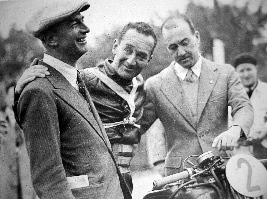
TT Isle of Mann, 1935, from left, Carlo Guzzi, Stanley Woods, Giorgio Parodi. (ref. No. 4)
" The management of MOTO GUZZI has corrupted in 1966, and it was carried
over to the new system, IMI, which was partly held by the Italian nation. "
In 1966, MOTO GUZZI released civilian V7 in Milan show at the end of
previous year, and would win the contest. Do you see that is the
corrupting company ? Was IMI really needed ?
I'd like to refer the words of Carcano once again.
" Our employer Parodi was really a good man. He
was severe, but a man of character. He was entrapped by the close
associates. It was nasty, disgusting... "
At this time, IMI laid off many employees. Not only Carcano, also
Micucci, who was the designer of small GUZZI and first 3X3, and many
person have left MOTO GUZZI.
In Italy there were some other examples of nationalization of private
company, like Alfa Romeo, and each might have its own background. And also
about the MOTO GUZZI, the officers would say some specious logic, like
a reinforce of production efficiency, etc.
No, their work did service little.
After this event MOTO GUZZI came back again, but it has done on its own
energy, and with one man's will who opposed to the officers.
Well, let's go back to the stage.
Development of V7 was let to the new team, with remained
staff like Umberto Todero, the right hand man of Carcano, and new
staff, like Lino Tonti, who was invited by SEIMM, the new management
after IMI.
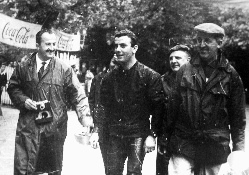
In 1962, most left is Tonti, still belonged to Bianchi. (ref. No. 19)
3.2 Development of V7
Lino Tonti was welcomed by various jobs, which is, drawing, test
course, sales, and so on, namely, all.
He must pick up user's requests or claims, and feed back them to the
design, realize it as a production model, and transfer to a mass
production model, keeping fine quality.
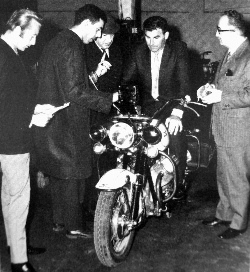
A view of an activity at a sales. Most left is George Kerker,
and far right is Tonti. (ref. No. 3)
V7 was a biggest motorcycle of MOTO GUZZI ever made, and its engine
architecture was also new for it. And more, the north american market
was new, too. V7's brushing up was continued after its debut in 1967.
One easy example of its maturity is the ribs on the surface of crank
case. Very first model of V7 had a crank case with flat surface, and then
as the model changing went on, ribs like a pattern of morning waffle
has appeared. It reinforced crank case so stiff.
And many improvements like that made V7 good robust, then, it has
become enough tough for a hard north american market.
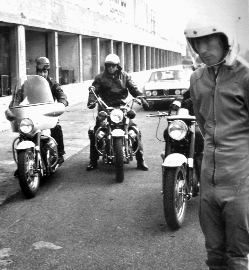
Staffs of a north american dealer, most right is Kerker. (ref. No. 3)
In north american market, there was a strong back up of local dealer.
They boldly began to sell V7 to police department.
U.S. police market was the newest and biggest official needs in the
world of that day. And the success in that market was a proof of high performance
and reliability. US dealer and MOTO GUZZI tried to pass the tests of
Los Angels Police department (L.A.P.D) beyond the hard effort of George
Kerker, US dealer staff who would become famous with his exhaust parts
company after that, and Lino Tonti. Their succeed can be seen over the
white GUZZI of U.S. police, and California models, with long handlebar
and step board, which was required to fit the police staff who was
already familiar with the riding position of Harley Davidson.
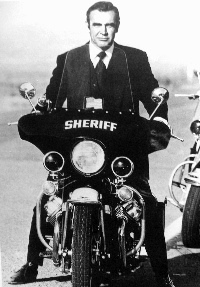
Which would fierce him or Inspector Harry Callahan ? (ref. No. 3)
The development of V7 continues after that, and Ambassador (757cc),
Eldorado and GT (844cc) succeeded. Matured and loved as good heavy
cruiser, V7 and its predecessor was manufactured until the mid of
1970's. Its production was quitted by De Tomaso, but the customers
struggled to get remained new bikes, they say.
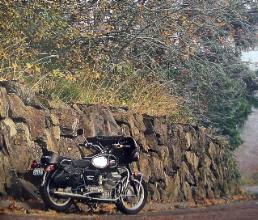
Nowadays they love Eldo, also in U.S. (ref. No. 3)
3.3 Birth of V7 sport
Tonti's next job was a try for a more sporty type of bike.
Many customers requested it and the dealer desired it. But the bigotry
SEIMM, organization of MOTO GUZZI of that days, was not interested in
it at all.
Tonti knew how was the V7 through the jobs described above, and that
may encouraged him to make it more faster one. That can be seen on the
achievement of world speed record in 1969.
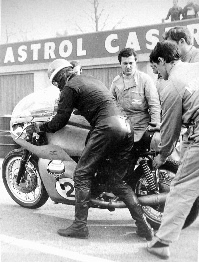
Speed trial in 1969 at Monza. (ref. No. 3)
Tonti was a racing motorbike designer in Bianchi, Paton, Linto, etc.
before MOTO GUZZI. He knew how was the sports bike, and conditions that
makes a bike interesting and exiting. He could design, and he also
fabricate it for himself.
Here, one defiance has budded.
In 1970, he started new bike development in his own garage with some
old friends of Aermacchi, apart from stubborn SEIMM and lazy
fabrication line on strike. The object was the sports production race
750cc class. He thought it needs next three, max. speed more
than 200km/h, weight less than 200kg, and 5 speed transmission.
Engine required few, some modification on V7 was the enough.
Problem was frame, it was a bit too "flexible". He focused job on it.
He moved electrical system from between the two cylinder to the front
end of engine, and dropped frame top tube there. He used straight pipes
as much, and tightened its alignment as possible. It fits like a glove,
but he also cared to fabrication and maintenance, its down tube was
fixed by bolts, and it made easy to mount the engine unit. It brought
good alignment, low steering head, high engine mount, deep bank angle,
and then, the new double cradle frame becomes small, light, and strong.
Modification of transmission from 4 to 5 speed was easy for him. And
then, the new bike appeared with its stylish silhouette. And the
development was finishing over his own testing.
He worked so energetic that it may be him who desired this GUZZI sports
bike most earnestly.
3.4 Release of V7 sport
SEIMM disapproved Tonti's job. Their purpose was just a
conservative benefit upon the models they already had. They didn't
understand the reason why they should try new models beyond the risk
with further investment at all.
The bud of defiance continued to grow.
First, he let the tasks on production to MOTO GUZZI technical
division. Since V7 sport had many newly designed parts, mass
production of it was not so easy. But Todero and his team worked well,
and till the mid of 1971 its production was almost ready.
Next, he did with some strategic action against the marketing tasks,
which is, the racing activity with "Telaio Rosso".
That is the racing special model of V7 sport, means "Red Frame". Its
frame had same alignment with production models but made with different
material. The engine was tuned up and assembled carefully one by one.
Gas tank was painted green with the image of glory dustbin era, and the
frame was red which reminds the historical horizontal single racers.
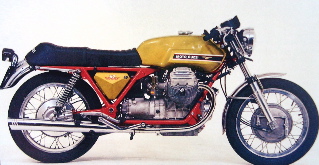
Telaio Rosso (ref. No. 3)
In 1971 June, at Monza 500km race, Telaio Rosso held second
position for long time, and finished 3rd. Next Bold'Or 24hrs in Sep.,
844cc Telaio Rosso kept 1st position at the beginning of the race for
10hrs, then finished 3rd and 6th.
"That cool and fast Italian eagle came back again to the circuit !"
Tonti showed what's the new GUZZI is, and the market was filled with
the desire for it. Tonti's second task was achieved. SEIMM had no any
reason to deny V7 sport.
It appeared Milan show in 1971, and from the latter half of that year,
it began to run on the production line "too".
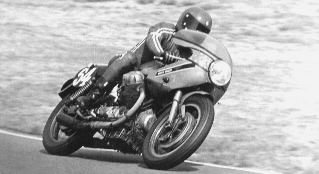
Telaio Rosso in Bold'Or (ref. No. 6)
I'd add some notes of Telaio Rosso.
It's not clear how many Telaio Rosso produced, but its scarcity might
show some premium value, even though it had some weakness for its
transmission. Someone say "It was produced 100 or 200 units, but now
there remains only 500". There may be many fakes with the frame painted
red afterward.
And there's another affections of it. It made notice for bike makers'
managers that it's a efficient job to show market a racing model before
its production begins. It may stir up their profit too.
3.5 What's new on V7 sport
I'd say V7 sport had two innovative point, that is, handling and styling.
It's fine handling is made on unique mass distribution. OHV V twin has
cam in the crank case, and only minimum mechanism for valve action
exists in engine head. Top of the engine is small, and Its mass
distribution is concentrated near the crank case. The engine sits a bit
high and forward compared to its rivals, that helps V7 sport to have
more load on its front tire, and contributes to achieve high speed
stability. For roll movement, engine moves with steering head linearly,
so its handling is very smooth from beginning of the bank to the deep
roll angle.
V7 sport has shaft drive system, but it doesn't behave rear body up and
down much. Rear tire traction pushed steering head directly through
the stiff Tonti frame, so you can control the acceleration
smoothly enough.
At this time MOTO GUZZI changed the design theory of motorbike, which
was, bring the load to rear wheel and make front wheel just to follow
the body. With V7 sport, you can control freely motorbike's body
mass near steering head (namely your hand) with the traction of engine
power. It's very comfort and enjoyable.
Braking stability may suffer high and front gravity point, but MOTO
GUZZI was solving it with integral braking system.
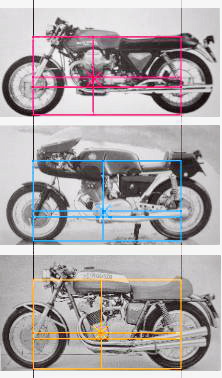
These photo show easy comparison of V7 sport with its rivals,
a bit rough drawing though.
From up to down, the models are,
V7 Sport (1971 ref. no. 1),
LAVERDA SFC (1971 ref. no. 11),
MV 750 sport (1973 ref. no. 15).
Lines on the each photo shows
height of steering head,
height of crank shaft,
wheel axle,
tire contact point,
respectively. And the "X" shows the point of crank case.
You can see that V7 sport has
steering head low,
crank shaft high and front ,
compared to the rivals in its structure.
Also its styling was brilliant.
At that time, motorcycle market was changed from traditional view of
old GUZZI lived. Almost all of the bikes exceeded its performance
beyond the average bikers' ability. And the reliability has improved
sufficiently, so riders didn't need to worry it would brake
or not. Then the styling raised its value as important appeal point to
the customers.
Tonti knew it, and he designed V7 sport to be a attractive silhouette.
(Some references says there were some contributes of Bertone staff.)
Seeing its low and condensed silhouette, customers expected power and
speed, and it was reinforced by the image of Telaio Rosso dancing
in the circuit. And for it's owners it also supported right handling
and comfort for a long period with high reliability. That was a quite
new style of MOTO GUZZI bike of next era.
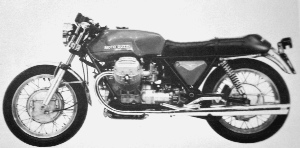
Low and condensed mass appeals ready to run. (ref. No. 1)
These good points were took over with its successor, LeMans. And the
frame developed at this time was arranged to many types of bikes, like
basic type of "T" series, grand tourer "SP", American luxury
"California", etc. It is used also nowadays, evaluated and appreciated
by many riders.
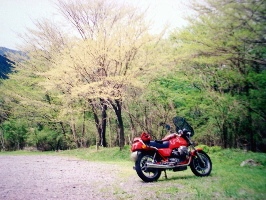
Nowadays they love Tonti frame, also in Japan.
After this story, Mr. Lino Tonti concerns MOTO GUZZI till 1990's. He
seems not to talk about his job so much. I don't know it's because he
is silent, or there's any restrains or fitters still now.
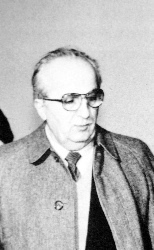
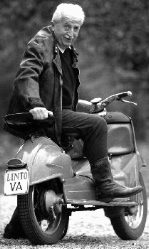
Left : In De Tomaso era, MOTO GUZZI was obscured. (from RIDERS CLUB No.57, 1988.3)
Right : Comparatively resent photo.
(from Anima Guzzista http://www.guzzisti.it)
And at MOTO GUZZI factory, you may see Mr. Todero, who worked with
Carcano and Tonti, still now.
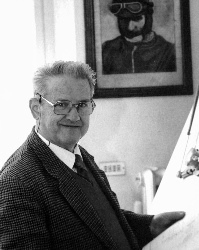
Mr. Todero at his office. (ref. No. 6)
Note.
Umberto Todero died at Sep. 2005, at 82 years old. I'd like to say
thanks much and good bye.
-- next : After V7 sport
-- to the page top
-- to the site top
Copyright(C) 2005-2009 Public-road Motorcycle Laboratory All rights reserved.














